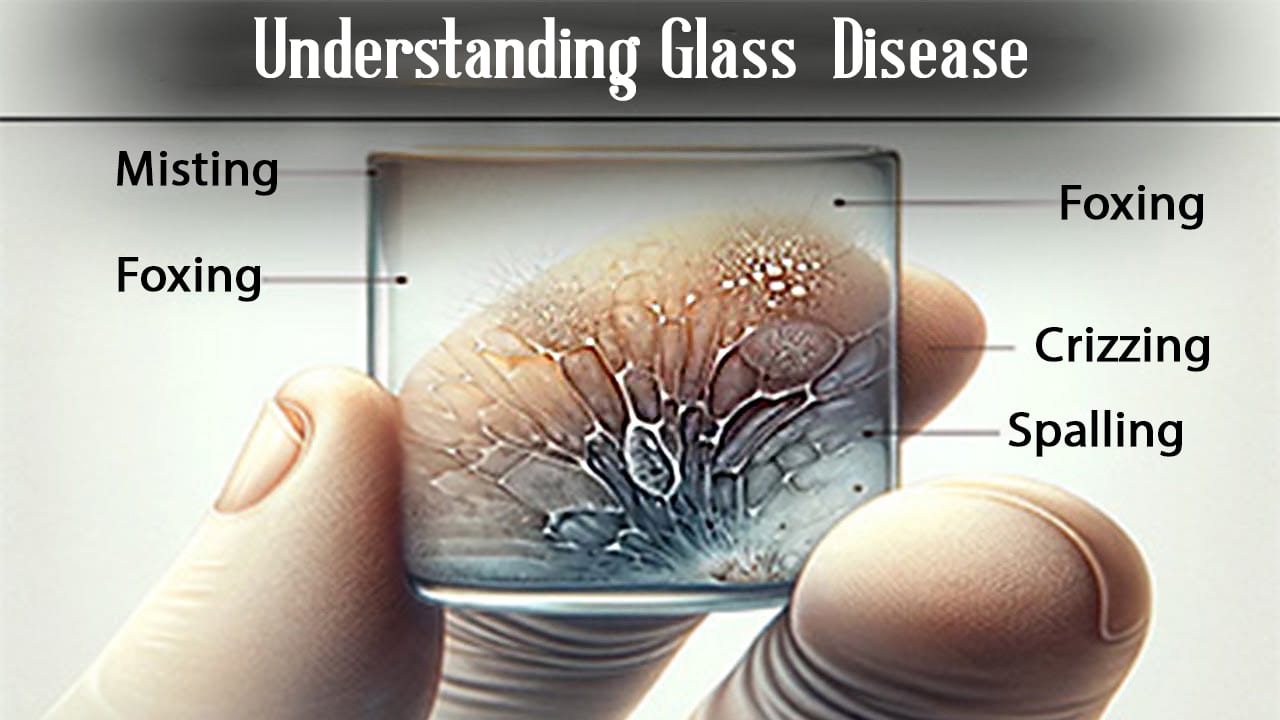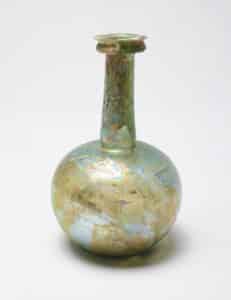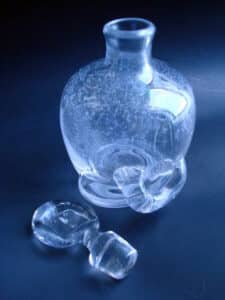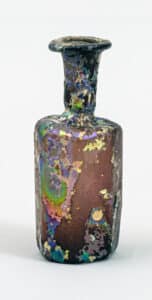Sick Glass and Ways to Deal With It
Content from Antiques Arena, antiquesarena.com. Used with permission.
Edited by Judy Gonyeau, managing editor, Journal of Antiques

Glass, a material celebrated for its beauty and durability, is not immune to the ravages of time and exposure to harsh environments. Collectors and enthusiasts often encounter glass objects afflicted by a condition known as “glass disease,” “sick glass,” or “glass illness.” This article explores the types, causes, and possible treatments for glass disease.
What is Glass Disease?
Glass disease refers to the progressive deterioration of glass due to chemical instability in its composition. It results in visible symptoms such as cloudiness (misting or foxing), surface flaking (spalling), fine cracking (crizzling), and even structural failure. It can affect all types of glass, including antique, colored, and uranium glass. These diseases dimmish the aesthetic and monetary value of glass objects, making them a significant concern for collectors, museums, and restorers.
What Causes Glass Disease?
Glass disease primarily stems from imbalances in the original composition of the glass. Here are the main factors:
Chemical Instability in Composition
Glass is composed of silica (SiO2), fluxes (e.g., soda or potash), and stabilizers (e.g., lime or magnesia). An imbalance, particularly a deficiency in stabilizers, makes the glass prone to deterioration. Without sufficient stabilizers, the alkali (e.g., sodium or potassium oxides) in the glass becomes water-soluble, leading to its leaching when exposed to moisture.
Environmental Factors
Humidity: High humidity accelerates leaching, causing surface deposits and other visible damage.
Temperature Fluctuations: Sudden changes in temperature can exacerbate existing weaknesses in the glass structure.
Prolonged Liquid Contact: Glass used for holding liquids for extended periods, such as vases and decanters, is particularly vulnerable to misting and foxing.

Sunlight Exposure: Prolonged exposure to direct sunlight can heat the glass, creating micro-expansions and contractions that may exacerbate chemical instability.
Additionally, UV radiation can contribute to alkali leaching and worsen misting or foxing over time. While sunlight itself does not directly cause glass disease, it can significantly accelerate its progression in already vulnerable pieces.
Historical Manufacturing Errors
Antique glass, such as early Venetian glass or 18th and 19th century decanters, often suffers from glass disease due to outdated or imperfect production methods. These pieces were not made with the chemical stability seen in modern glassware.
Causes of Glass Disease
Glass disease is primarily caused by inherent instability in the chemical composition of glass. Factors such as the proportion of silica, alkali, and alkaline earth in the glass affect its stability. Environmental factors like humidity, temperature fluctuations, and exposure to water can accelerate the degradation process. These pieces were not made with the chemical stability seen in modern glassware.
Types of Glass Disease
Misting (Foxing or Blooming)
• What It Is: A milky, cloudy layer on the surface or interior of the glass.
• Cause: Alkali leaching out of the glass and reacting with moisture in the air.
• Characteristics: Often disappears when wet but reappears as the item dries. Common in vases, decanters, and drinking glasses.
• Treatment: Minor misting can be polished; severe cases may require professional restoration. Gentle cleaning with mild conservation detergent and de-ionized water can sometimes slow further deterioration.
Spalling
• What It Is: Flaking or pitting of the glass surface.
• Cause: Severe leaching and structural breakdown due to prolonged exposure to moisture.
• Characteristics: Irreversible in most cases. It is common in thinner glass, where structural integrity is easily compromised.
• Treatment: Grinding and polishing may work for thicker glass but are not feasible for thin or delicate pieces.
Crizzling
• What It Is: A network of fine cracks resembling crazing.
• Cause: Crizzling occurs as a result of the glass reacting with water vapor in the air. Loss of alkali over time, leading to microscopic gaps in the glass structure
• Characteristics: Common in historical glass, such as Venetian or 17th-century pieces. Sometimes, it is deliberately created for artistic purposes (e.g., by rapid cooling).
• Treatment: Controlled humidity (40-55%) and air movement can slow crizzling. Once started, it cannot be reversed; it can only be managed.

Weeping
• What It Is: Moisture accumulating on the glass surface in humid environments.
• Cause: Continuous alkali leaching.
• Characteristics: Glass feels slippery or “wet;” leaves behind deposits when dried.
• Treatment: Reducing humidity levels can help prevent further weeping.
• What It Is: Breaking or severe structural damage due to advanced degradation.
• Cause: Long-term exposure to environmental stressors or improper handling.
• Treatment: Irreversible, but preventive measures like humidity control are crucial.
How to Treat and Prevent Glass Disease
• Cleaning Techniques For Misting and Foxing:
• Use a glass polishing compound (e.g., automotive grinding paste).
• Apply the compound using a soft cloth or polishing pad.
• Use a cordless drill with a polishing attachment for larger areas to speed up the process.
• Always rinse thoroughly with clean water and dry immediately.
• Cleaning Techniques for Minor Weeping or Surface Deposits
• Use a mixture of three parts water and one part vinegar.
• Soak the glass for a few days, then rinse and dry thoroughly.

• Professional Restoration for Severe Cases (e.g., decanters with inaccessible interiors)
• Consider professional acid dipping. This process removes misting and deposits but comes with significant trade-offs. Acid dipping softens sharp decorative cuts, reducing their crispness, and this alteration can be classified as both damage and restoration.
• Collectors should weigh these factors carefully, especially for high-value or historically significant pieces.
• Grinding and polishing can restore thick glass with spalling but may not work on thin or fragile items.
• Environmental Control
• Maintain a stable humidity level between 40% and 55%.
• Avoid exposure to high temperatures or rapid humidity fluctuations.
• Store glass in well-ventilated, climate-controlled environments.
• Preventive Measures
• Regularly inspect antique glass for signs of deterioration.
• Avoid prolonged exposure to liquids, especially in collectible or valuable pieces.
• Desiccants or silica gel can be used in storage areas to control humidity.
Practical Examples & Case Studies
Example 1: Uranium Glass with Spalling – A set of uranium drinking glasses exhibited spalling on their bases. While the glow under UV light added aesthetic appeal, the flaking severely impacted their structural integrity. Polishing was deemed unsuitable due to the thin glass.
Example 2: Antique Decanter with Misting – A Georgian decanter with heavy internal misting was professionally treated through acid dipping. While the misting was removed, the sharpness of the cuts was slightly diminished, illustrating the trade-offs of this restoration method.
Why Glass Disease Matters to Collectors
Value Impact: Glass disease significantly reduces the resale value of affected items. Misted or damaged glass often sells for a fraction of its original worth.
Restoration Opportunities: Collectors can restore lightly misted pieces for personal use or resale. Simple polishing methods can transform a flawed item into a pristine display piece.
Preservation of History: Understanding and addressing glass disease helps preserve cultural and historical artifacts for future generations.
Glass disease, while daunting, is manageable with the proper knowledge and tools. Collectors and enthusiasts can confidently preserve their glass treasures by understanding its causes, types, and treatments. Whether restoring a misted vase or safeguarding a delicate decanter, proper care ensures these beautiful artifacts endure the test of time.
Antiques Arena provides a comprehensive suite of services for enthusiasts and collectors of antiques and unique items. Located in the U.K., it provides expert identification and valuation services, provide insightful advice based on your provided images, to personalized product reviews and endorsements showcased across their multi-platform channels. Visit https://antiquesarena.com to learn more.






